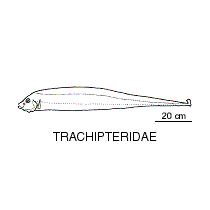- Classification
- ACTINOPTERYGII
- LAMPRIDIFORMES
- TRACHIPTERIDAE
-
Fish Classification
-
Class
ACTINOPTERYGII Ray-finned fishes -
Order
LAMPRIDIFORMES Opahs, ribbonfishes -
Family
TRACHIPTERIDAE Ribbonfishes
Family TRACHIPTERIDAE
More Info
|
Family Taxonomy |
Small family with 3 genera and at least 10 species; all genera and 3 species occur in Australian waters. |
|
Family Distribution |
Cosmopolitan in all oceans; meso- to bathypelagic depths. |
|
Family Description |
Body elongate, compressed, tapering from large head to very narrow caudal peduncle, eye large; mouth highly protrusible, teeth present. Dorsal fin very long, originating well behind tip of snout, highest anteriorly,extending nearly full length of body; anal fin generally absent; pelvic fins elongate in juveniles, reduced or absent in adults; caudal fin long, upper lobe only prsent in most species and oriented perpendicular to body, lower lobe absent. Scales cycloid or modified ctenoid, deciduous; skin of adults covered with small, bony tubercles, juveniles with posteriorly directed spinules along lateral line, scattered over caudal peduncle and on caudal rays. Swim bladder rudimentary, if present. |
|
Family Size |
Reach about 2.2 m. |
|
Family Feeding |
Carnivores, feeding on other fishes, squids and crustaceans. |
|
Family Reproduction |
Oviparous, with planktonic eggs and larvae. All species undergo considerable allometric growth and remarkable ontogenetic changes between larval and adult stages. Eggs 1.8-3.2. mm, spherical, pelagic and often pale orange or reddish in colour. Larvae at all growth stages are highly pigmented. At hatching, larvae have well-developed, protrusible jaws, pigmented eyes and functional differentiated guts. An elaborate, long anterior dorsal filament develops behind the head, ornamented at intervals with pigmented swellings. Pelvic fin elements well-developed and ornamented. |
|
Family Commercial |
Very occasionally taken as bycatch in commercial fisheries. |
|
Family Remarks |
Ribbonfishes swim in an eel-like fashion by undulating the dorsal fin. |
|
Family Biology |
Martin, J.M. & Hilton, E.A. 2021. A taxonomic review of the family Trachipteridae (Acanthomorpha: Lampridiformes), with an emphasis on taxa distributed in the western Pacific Ocean. Zootaxa 5039(3): 301–351 https://doi.org/10.11646/zootaxa.5039.3.1 |
|
Author |
Bray, D.J. 2021 |
References
Charter, S.R. & H.G. Moser. 1996. Lampridiformes, Lophotidae, Radiicephalidae, Trachipteridae. In The early stages of fishes in the California current region. California Cooperative Oceanic Fisheries Investigations Atlas No. 33, pp. 659-677.
Heemstra, P.C. & S.X. Kannemeyer. 1984. The families Trachipteridae and Radiicephalidae (Pisces, Lampriformes) and a new species of Zu from South Africa. Ann. S. Afr. Mus. 94: 13-39.
Moser, H.G. (ed.) 1996. The Early Stages of Fishes in the California Current Region. CalCOFI Atlas No. 33 Ed. Allen Press Inc, Lawrence, Kansas. 1505 pp.
Okiyama, M (ed.) 1988. An Atlas of the Early Stage Fishes in Japan. Tokai University Press, Tokyo. 1154 pp. [in Japanese]
Olney, J.E. 1984. Lampridiformes: development and relationships. Pp. 368-379, In Moser, H.G., W.J. Richards, D.M. Cohen, M.P. Fahay, A.W. Kendall, Jr. & S.L. Richardson (eds). Ontogeny and Systematics of Fishes. Spec. Publ. No. 1, Amer. Soc. Ichthy. Herpet., ix + 760 pp.
Olney, J.E. 1999. Trachipteridae: Ribbonfishes (dealfishes), In Carpenter, K.E. & V.H. Niem. Species identification guide for fisheries purposes. The living marine resources of the western central Pacific. Batoid fishes, chimeras and bony fishes. Part 1 (Elopidae to Linophrynidae). FAO, Rome.
Olney, J.E., G.D. Johnson & C.C. Baldwin. 1993. Phylogeny of lampridiform fishes. Bull. Mar. Sci. 52:137-169.
Olney, J.E. & A. Naplin. 1980. Eggs of the Scalloped Ribbonfish, Zu cristatus, (Pisces: Trachipteridae) in the Western North Atlantic. Copeia 1980(1): 165-166.























